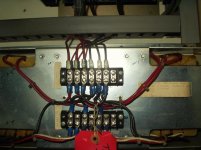npolanosky
Cast Iron
- Joined
- Apr 9, 2016
- Location
- USA, FL
Hi all,
I'm running a 1991 HAAS VF-1 which has been brought back from the dead a few times. It's been running well lately now that I have squashed most of the problems, but there's one issue still remaining: When running at 100% rapids, I occasionally get an Over Voltage alarm (119 IIRC). This only happens after running for a little bit and so far as I can tell the incoming line voltage is OK. The DC bus voltage usually sits on the higher side but not outside of the limits.
I've been running the machine for a few months at 50% rapids and it does great, but I have been doing a fair bit of 3d machining and some production work lately and the faster rapids would save me a not-insignificant amount of time. Has anyone seen this before, and do you have any suggestions?
Some brief searching turns up results pointing to the brake resistors overheating, caps going out of spec, and bad control boards. I'm hoping it's one of the first two or something even easier to fix, but I'd like to hear from some folks directly instead of mindlessly google-fu-ing my way through this.
I am working towards a newer machine eventually, but I am currently maintaining a day job and doing job shop work in the evening so I'm stuck with what I've got for a little while longer, especially if I first pick up a CNC lathe instead of a newer mill.
I'll be at the shop this evening and I can check exact voltages and temperatures if needed.
Thanks in advance!
I'm running a 1991 HAAS VF-1 which has been brought back from the dead a few times. It's been running well lately now that I have squashed most of the problems, but there's one issue still remaining: When running at 100% rapids, I occasionally get an Over Voltage alarm (119 IIRC). This only happens after running for a little bit and so far as I can tell the incoming line voltage is OK. The DC bus voltage usually sits on the higher side but not outside of the limits.
I've been running the machine for a few months at 50% rapids and it does great, but I have been doing a fair bit of 3d machining and some production work lately and the faster rapids would save me a not-insignificant amount of time. Has anyone seen this before, and do you have any suggestions?
Some brief searching turns up results pointing to the brake resistors overheating, caps going out of spec, and bad control boards. I'm hoping it's one of the first two or something even easier to fix, but I'd like to hear from some folks directly instead of mindlessly google-fu-ing my way through this.
I am working towards a newer machine eventually, but I am currently maintaining a day job and doing job shop work in the evening so I'm stuck with what I've got for a little while longer, especially if I first pick up a CNC lathe instead of a newer mill.
I'll be at the shop this evening and I can check exact voltages and temperatures if needed.
Thanks in advance!



